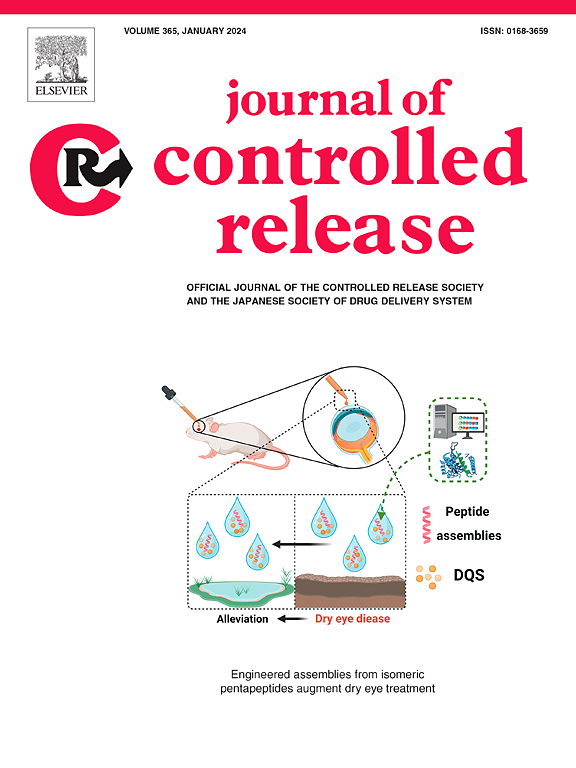Drug and therapeutic delivery targeting diseases in the vaginal environment: A mathematical modeling perspective
IF 10.5
1区 医学
Q1 CHEMISTRY, MULTIDISCIPLINARY
引用次数: 0
Abstract
Localized vaginal drug and therapeutic delivery targeting diseases is advantageous, yet presents significant challenges due to unique anatomical features, cyclic variations, and a complex microbial ecosystem. Disruption of the intricate vaginal environment due to dysbiosis or infection can decrease immune protection and lead to infertility and pregnancy complications. A variety of intravaginal drug delivery systems (DDS) including creams, gels, suppositories, tablets, rings, and films have been developed to address these conditions. However, relying solely on empirical methods to design and evaluate DDS composition and geometry, as well as dosing regimens, would be costly and time intensive. To address these challenges, mathematical modeling has recently emerged as a complementary tool to systematically evaluate intravaginal DDS performance as a function of drug diffusion, reactions, and biomechanical interactions. This review summarizes how the application of mass conservation and the integration of mechanistic and empirical methods can offer insight into DDS pharmacokinetics and pharmacodynamics. Models describing first-order kinetics, microbial interactions, formulation optimization, rheological behavior, and interactions with the vaginal environment are critically evaluated. It is shown that these models can systematically evaluate how various physical phenomena such as diffusion, swelling, dilution, surface slip, and mechanical compression interact to shape spatiotemporal patterns of drug release, permeability, and microbial dynamics. Challenges and limitations of current approaches as well as emerging technologies are discussed, with the goal to provide insight into how mathematical modeling may benefit the development of effective intra-vaginal therapies addressing female reproductive tract diseases.

针对阴道环境中疾病的药物和治疗递送:一个数学建模的视角
针对疾病的局部阴道药物和治疗递送是有利的,但由于独特的解剖特征,循环变化和复杂的微生物生态系统,提出了重大挑战。由于生态失调或感染而破坏复杂的阴道环境可降低免疫保护,导致不孕和妊娠并发症。各种阴道内给药系统(DDS),包括乳霜、凝胶、栓剂、片剂、环和薄膜,已经开发出来解决这些问题。然而,仅仅依靠经验方法来设计和评估DDS的组成和几何形状以及给药方案将是昂贵和耗时的。为了解决这些挑战,数学建模最近成为系统评估阴道内DDS性能的补充工具,作为药物扩散、反应和生物力学相互作用的函数。本文综述了质量守恒的应用以及机制与经验相结合的方法对DDS药代动力学和药效学的研究。模型描述一级动力学,微生物相互作用,配方优化,流变行为,并与阴道环境的相互作用进行了严格的评估。研究表明,这些模型可以系统地评估各种物理现象,如扩散、膨胀、稀释、表面滑动和机械压缩如何相互作用,从而形成药物释放、渗透性和微生物动力学的时空模式。讨论了当前方法以及新兴技术的挑战和局限性,目的是深入了解数学建模如何有助于开发有效的阴道内治疗女性生殖道疾病的方法。
本文章由计算机程序翻译,如有差异,请以英文原文为准。
求助全文
约1分钟内获得全文
求助全文
来源期刊

Journal of Controlled Release
医学-化学综合
CiteScore
18.50
自引率
5.60%
发文量
700
审稿时长
39 days
期刊介绍:
The Journal of Controlled Release (JCR) proudly serves as the Official Journal of the Controlled Release Society and the Japan Society of Drug Delivery System.
Dedicated to the broad field of delivery science and technology, JCR publishes high-quality research articles covering drug delivery systems and all facets of formulations. This includes the physicochemical and biological properties of drugs, design and characterization of dosage forms, release mechanisms, in vivo testing, and formulation research and development across pharmaceutical, diagnostic, agricultural, environmental, cosmetic, and food industries.
Priority is given to manuscripts that contribute to the fundamental understanding of principles or demonstrate the advantages of novel technologies in terms of safety and efficacy over current clinical standards. JCR strives to be a leading platform for advancements in delivery science and technology.
 求助内容:
求助内容: 应助结果提醒方式:
应助结果提醒方式:


